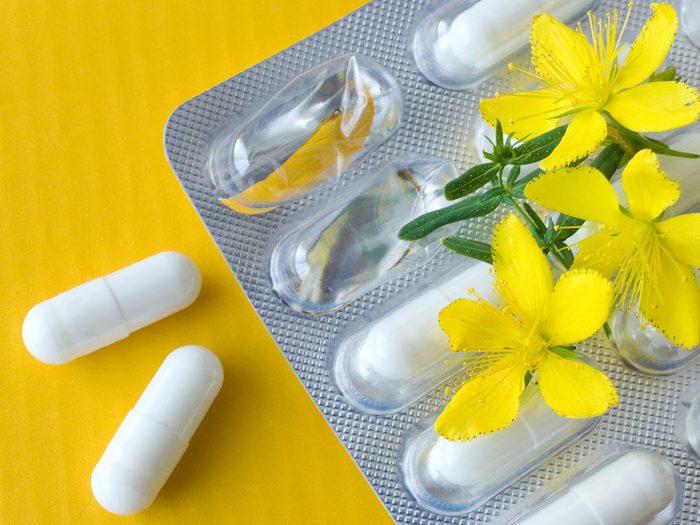How St. John’s Wort Can Help Fight Depression
An unsuspecting sunshine-yellow flower, St. John’s Wort is known for its mood boosting effect and is used to help treat depression

Source: The Amazing Healing Powers of Nature, Reader’s Digest
Hesitant to try antidepressants? St. John’s Wort may be the natural remedy you need to fight depression.
St. John’s Wort is a common herbal remedy used to treat mild to moderate depression. It is most often taken as a tincture or in capsule form, and can also be made into tea.
How St. John’s Wort works
When soaked in alcohol, the sunshine-yellow flowers of St. John’s Wort (Hypericum perforatum) release a burgundy-hued extract rich in hypericin.
St. John’s Wort contains at least 7 substances’including hypericin’that counter depression. One, Hyperforin, seems to function like popular selective serotonin reuptake inhibitor drugs, such as Prozac, by inhibiting the reuptake of a number of mood-elevating brain chemicals, including serotonin, dopamine, norepinephrine and gamma-aminobutyric acid, by brain cells.
The longer these neurotransmitters are in play, the better you feel.
Does St. John’s Wort really work?
St. John’s Wort isn’t a miracle cure for the low moods that affect 121 million people worldwide, but it may help some. Scientists have reported that both St. John’s Wort and conventional antidepressants are similarly effective. And in a review of 29 studies involving 5489 people, researchers from Germany’s Technical University of Munich reported that one in four taking the herb halted treatment as a result of side effects compared to one in two taking a mood-lifting drug.
Think you might be depressed? Starting out on St. John’s Wort
If you’d like to try St. John’s Wort for depression, choose a product standardized to 0.3 percent hypericin or 2 to 4.5 percent hyperforin and take 300 milligrams 3 times a day.
Consult your doctor first, though. This herb can interact with other antidepressants, birth control pills, the organ transplant drug cyclosporine, the heart medicine digoxin, indinavir and possibly some HIV, cancer drugs, seizure and anticlotting drugs as well. Stay in touch with your doctor; if depression does not improve in 2 to 4 weeks, explore other treatments.
The future of St. John’s Wort
Scientists are looking closely at other uses for compounds found in St. John’s Wort. In lab studies, 2 of these, hypericin and pseudohypericin, have knocked back many types of viruses including influenza A and hand, foot and mouth disease, a highly contagious but usually mild, blister-raising infection.
The rise and fall of St. John’s Wort
In the 1990s, the apparent mood-boosting effects of St. John’s Wort earned the ancient herb a new image as a depression-conquering superstar. Television shows and magazines hailed it as ‘nature’s Prozac’ and the ‘most-used antidepressant in the history of humanity,’ though traditionally, St. John’s Wort was used as a treatment for nerve pain, wounds, burns and insect bites.
Small wonder then, given the media buzz, that St. John’s Wort sales soared from $20-million in 1995 to nearly $315-million in 1998 in the United States alone, while in Germany the herb was prescribed 20 times more often than conventional drugs for depression. Supplies even ran short, particularly as word spread about a blockbuster British Medical Journal review of 23 studies involving 1757 people with mild to moderate depression. It compared the effects of St. John’s Wort, standard antidepressants and a placebo’and concluded that the herb had a depression-lifting effect similar to drugs, but with less than half the side effects.
The ultrapopular botanical was knocked off its pedestal in 2002, when a study sponsored by the US National Institutes of Health found a ‘complete absence’ of improvement in people with moderately severe depression. Reports of potentially serious herb-drug interactions followed, including birth-control pills that didn’t work as well, reduced levels of chemotherapy drugs in people under-going cancer treatment and rising cholesterol levels in people taking some types of statin (cholesterol lowering) drugs while also using St. John’s Wort. Sales fell to $100-million by 2003 in the United States. But the story wasn’t over. Instead, a clearer picture of this remedy’s best uses’and real-world risks’was emerging.
Did you know?
‘ St. John’s Wort was traditionally harvested on St John’s Day, June 24th, hence its name.
‘ Two-fifths of adults with depression use alternative treatments; most don’t tell their doctors.
‘ Despite its healing properties, St. John’s Wort is considered a noxious weed in 20 countries including Australia, France, Italy, Turkey, Sweden and the United States. (Its origins are in Europe, western Asia and North Africa.)
‘ This hardy plant crowds out native species and can trigger severe sunburns if eaten by livestock. The sticky seeds stay viable in soil for up to 10 years and can hitch rides on fur, feathers, clothing, tyres and even machinery. The plant thrives in almost any conditions and also spreads via underground runners called rhizomes.




